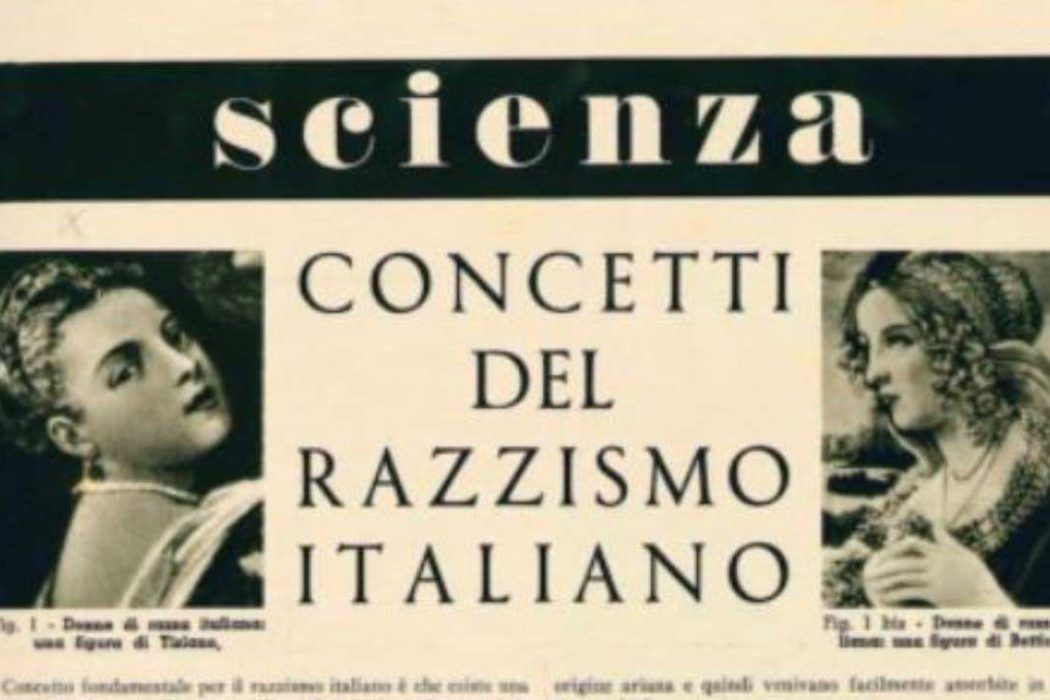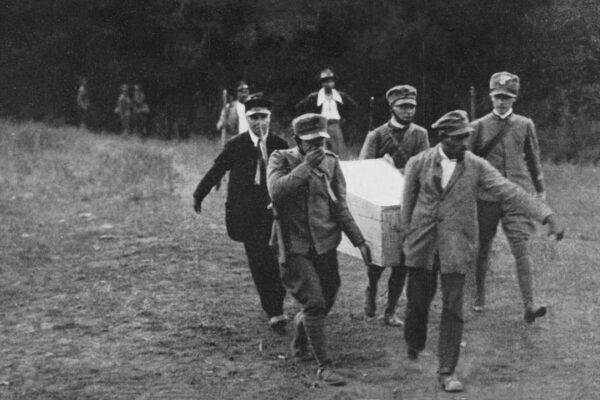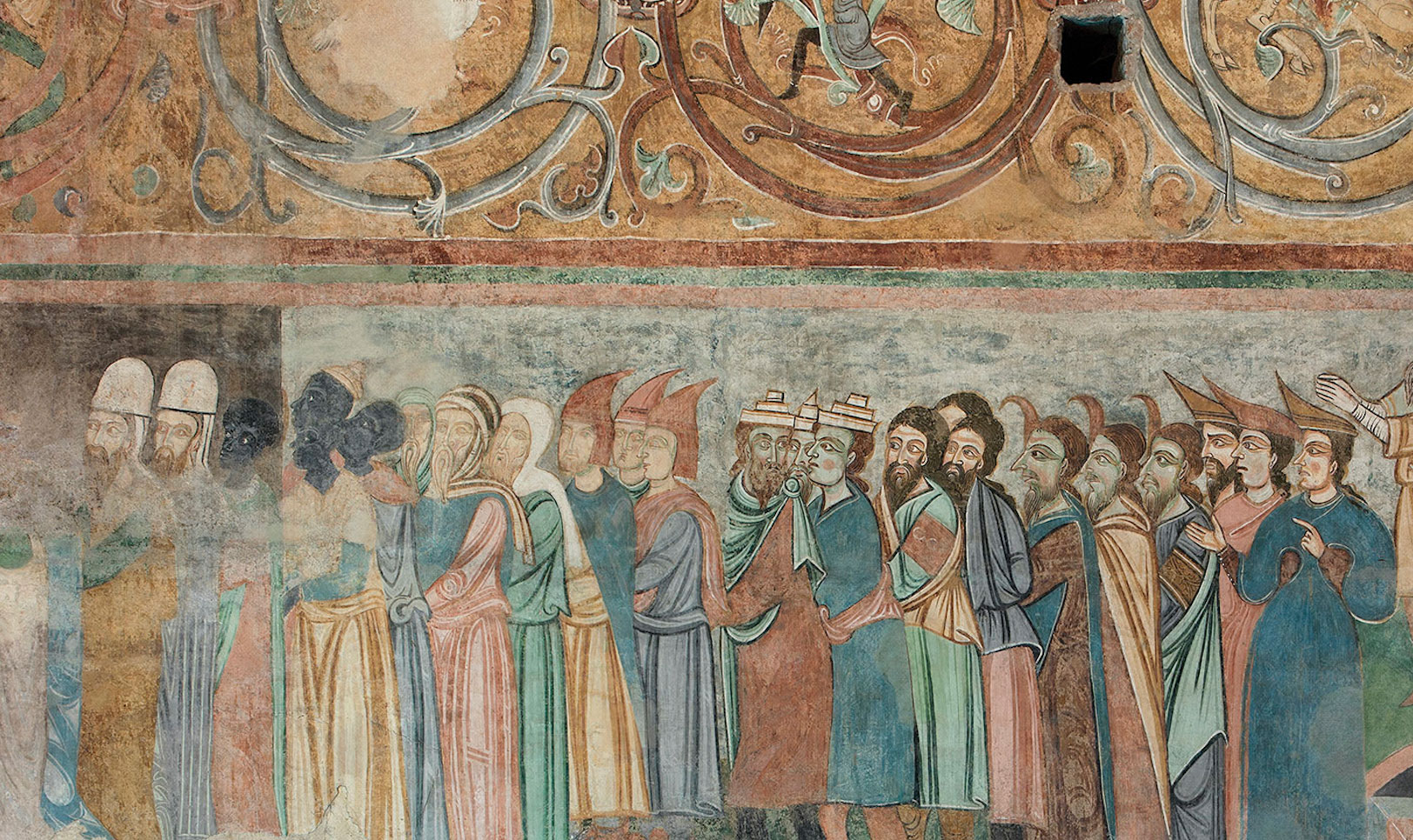Journal of Modern Italian Studies: On the 80th anniversary of the Racial Laws. Articles reflecting the current scholarship on Italian Fascist anti-Semitism in honour of Michele Sarfatti.
Annalisa Capristo and Ernest Ialongo (Journal of Modern Italian Studies)
2018 marks the 80th anniversary of the Racial Laws introduced in Fascist Italy by the dictator Benito Mussolini. As often happens with decennial milestones of major historical events, an opportunity is afforded to look back and see the progress of the relevant scholarly literature, and what future directions may be mapped out. Also, as in this particular case, it is an opportunity to pay homage to one of the central, if not the central, figure that has shaped the current thinking on Italian Fascist anti-Semitism, Michele Sarfatti. As such, we, the co-editors of this special issue of the Journal of Modern Italian Studies, Annalisa Capristo and Ernest Ialongo, asked a series of European scholars working in Fascist anti-Semitism to contribute to this issue in honour of Michele Sarfatti. Their task was twofold. First, to produce an article in English that highlighted the new work they were doing in the field, so that we could bring the latest work in Fascist anti-Semitism to an English-speaking audience, and, second, to note the role that Sarfatti’s work played in their own scholarship. The articles we offer in this issue all seek to push further Sarfatti’s original goal to look deeper into this period in Italian history and to forever erase the notion of ‘Italiani brava gente’, wherein the Italian role in the persecution of the Jews and in the Holocaust was downplayed when placed against the actions of Nazi Germany. In this pre-Sarfatti consensus, Mussolini was not considered a racist, and it was argued he ultimately adopted the Racial Laws for mainly diplomatic purposes to ally his nation with Nazi Germany; that the Racial Laws in Italy were not as harsh as similar laws in other countries; that the Church was against the racial turn and worked against its various forms of implementation; that the Italian people themselves were never enthusiastic supporters of the laws and that most people helped their Jewish neighbours during this period of persecution; that elements of the army worked to undermine the persecution of the Jews and refused to hand them over to the Nazis in their respective areas of control in Europe; and finally that during 1943–1945 the rounding up of the Jews and their shipment to Auschwitz for extermination was solely the work of the Nazi German occupiers who had taken over central and northern Italy. This was the consensus up to the 1980s, which Sarfatti and others have systematically dismantled.
The starting date for this new phase in the historiography of the Fascist persecution of Jews in Italy is unanimously considered to be 1988 (Schwarz 2008, 2012, 2014), the 50th anniversary of the promulgation of the so-called ‘Racial Laws’, or, more correctly, ‘Racist Laws’ (Sarfatti 2002, p.5). In addition to the publications associated with official commemorations, such as those promoted by the Chamber of Deputies and the Senate of the Republic, a volume was issued that year which is still today considered fundamental, a special issue of the journal La Rassegna mensile di Israel, jointly published by the Union of the Italian Jewish Communities and the Foundation Jewish Contemporary Documentation Center (hereafter C.D.E.C.), and edited by Michele Sarfatti.
The issue published facsimile reproductions of the laws taken from the Gazzetta Ufficiale, as well as key circulars issued by the Fascist government between 1938 and 1945, together with several historical essays. This publication opposed the reality of a harsh and detailed legislation to the conventional narrative which considered the Italian anti-Jewish legislation enacted between 1938 and 1943 (at a time when the Fascist government held full sovereignty) to be mild and basically ineffective. On the contrary, it clarified the fact that the margin for the exemptions was extremely narrow and that the majority of Italian Jews was actually placed in a position of ‘pariah’. Furthermore, the complete reproduction of the decrees highlighted the dramatic circumstances of foreign Jews who were given six months to leave the Italian territory. This group also included those whose Italian citizenship, granted from 1 January 1919 onwards, was revoked (Voigt 1989–1993).
On the whole, this was a significant modification of the self-exonerating but basically distorted image of the Fascist anti-Semitic legislation as ‘much less personally oppressive’, when ‘compared to that of other countries’ as described by Renzo De Felice ([1961] 1993, p.256, 2001, p.240). On the other hand, this false representation had its roots in a factual error, as Michele Sarfatti has recently explained (2017, p.8). In describing Fascist policy in the second half of 1938, in fact, De Felice had highlighted statements made by Mussolini to reassure national and international public opinion between August and September, and above all a provisional document such as the Dichiarazione sulla razza(Declaration on Race), approved by the Grand Council of Fascism on 6 October 1938, which indicated that there would be broad exemptions for Jews of recognized political, military or scientific standing, the so-called ‘discriminazione’. In his book, De Felice cited the Grand Council’s declaration extensively, while he relegated the decree of 17 November 1938, which was far more restrictive, to the appendix; in the text, he merely notes that ‘this decree actually turned into laws the most important points of the Grand Council meeting’ (De Felice [1961] 1993, p.307; 2001, p.294). Though he underscored some amendments to the final version of the law, this was inadequate to understand that the measures had been generally and seriously exacerbated. Over the following years, other important publications helped shed light on a number of aspects of the Fascist policy towards Jews.
In 1991, the first edition of the monumental work Il Libro della Memoria(The Book of Remembrance) by C.D.E.C. historian Liliana Picciotto was published (Picciotto 1991, 2002). It was the first detailed reconstruction of the Italian chapter in the Shoah. Based on painstaking research that brought together numerous sources, this work included the almost complete list of names of the Jews deported from Italy and from Italian territories in the Dodecanese.1 The author provided a detailed picture of the organizations in charge of carrying out the ‘Final Solution’ in Italy. This work presented, for the first time, the number and the names of Italian victims of extermination. What emerged, above all, were the Italian responsibility and complicity in making arrests and in the subsequent phases of detention and transfer of the Jews to the German authorities, to be deported to the extermination camps. After The Book of Remembrance, therefore, it was no longer possible to claim – as De Felice had done in an interview to the newspaper Corriere della Sera in December 1987 – that Italian Fascism was ‘outside the ring of shadow of the Holocaust’.
In 1994 two more important contributions were published that presented a profound revision of De Felice’s interpretation. The first was Michele Sarfatti’s Mussolini contro gli ebrei: Cronaca dell’elaborazione delle leggi del 1938 (1994, 2017). In his book the author supported two new arguments. First of all, he refuted the claims that the anti-Jewish legislation enacted in the second half of 1938 had been the result of ‘speed’, ‘shallowness’ and ‘Mussolini’s slipshod approach’ (De Felice [1961] 1993, p.281, p.344, 2001, p.266, p.331). On the contrary, Sarfatti demonstrated that the final decrees were the result of a complicated decision-making process by the dictator who adopted an increasingly persecutory attitude. Sarfatti also underlined the ‘biological’ approach of anti-Jewish legislation as conceived by Mussolini, beyond all the propaganda concerning the ‘spiritual’ nature and the unique character of Italian racism. In the classification of those who were to be persecuted, in fact, the ‘blood’ factor annulled the denominational factor: children of Jewish parents were always classified as ‘belonging to the Jewish race’, even if they were baptized. The classification of half-Catholics as ‘not belonging to the Jewish race’ even complied with the biological guiding principle: according to the notion of the ‘racial superiority of “Italian blood”’, ‘in mixed blood it was considered to prevail over Jewish blood’ (Sarfatti 1994, p.8, p.112, 2017, p.15, p.127).
The second book was the substantial catalogue of the exhibition La Menzogna della Razza(The Lie About Race), which took place in Bologna that same year (Centro Furio Jesi 1994). This work, in its way, was another turning point for the historiography on anti-Semitism and Fascist racism. We note here two particularly relevant additions to the subject. The first is the letter from the anthropologist Guido Landra to Mussolini dated 27 September 1940, which is decisive for the overall reconstruction of the circumstances surrounding the writing of the statement Il fascismo e i problemi della razza (Fascism and the Problems of Race), also known by the misleading title Manifesto degli scienziati razzisti (Manifesto of the Racist Scientists) (Sarfatti 2006, p.128). Contrary to what was affirmed by De Felice ([1961] 1993, p.279, 2001, pp.264–265), the document showed that Mussolini had with reason claimed authorship of this statement during the Grand Council of Fascism meeting of 6 October 1938, as reported in Bottai’s diary: ‘I practically dictated it myself’ (De Felice [1961] 1993, p.303, 2001, p.289). In his contribution, Mauro Raspanti, the scholar who discovered the letter, thoroughly analysed three different variations of Fascist racism (‘biological’, ‘national’, and ‘esoteric-traditionalist’) and disproved the view – which nonetheless has been revived in recent studies – that it was a less ‘racist’ racism than the German-type that prevailed in Italy (Raspanti 1994). Another relevant finding in the catalogue concerned the marked exacerbation of the anti-Jewish policy between May and July 1943. New documents have shown that, shortly before the fall of the regime, Mussolini had given orders to set up new forced labour camps for Italian Jews – i.e. real ‘concentration camps’. The plan was then disrupted by the political crisis of 25 July, but these new documents shed a sinister light on the goals of Fascist anti-Jewish policy, in particular in the escalated state of war (Centro Furio Jesi 1994, pp.369–372).
Another milestone occurred in 1997, when the Annali Einaudi presented a first reconstruction by Michele Sarfatti of the fate of Italian Jews under Fascism, which three years later was to develop into the book Gli ebrei nell’Italia fascista: Vicende, identità, persecuzione (Sarfatti 1997, 2000). When this book was published in English as The Jews in Mussolini’s Italy: From Equality to Persecution, the English-speaking world was given a sense of the changes that were occurring in the study of Fascist anti-Semitism (Sarfatti 2006).
Broadening the reach of this new work into the realm of culture, in 1998 Giorgio Fabre published an ample study of Fascist censorship and Jewish authors that brought to light much new information about the racist and anti-Semitic politics of the regime (Fabre 1998). Fabre’s work highlighted the connection between Mussolini’s political actions and the racist ideology (anti-black and anti-Semitic) that stood behind his interventions against the press, whether books or periodicals.
Two more books were published between 1998 and 1999 and, with different approaches, they both considered the issue of relations between scientists and Fascism with regard to the development of the racist ideology. They both took a critical view, at least partially, of De Felice’s interpretation. According to De Felice, racism and anti-Semitism were for the most part alien (apart from a few isolated cases) to Italian culture, scientific culture included. With a few exceptions, most intellectuals and scientists had in 1938 allegedly joined in the anti-Semitic campaign out of expediency, in some case attempting to ‘reject the German and German-style aberrations’ (De Felice [1961] 1993, p.393, 2001, p.378). Instead, Giorgio Israel and Pietro Nastasi (1998), as well as Roberto Maiocchi (1999), have highlighted the significance of a consolidated Italian tradition of scientific racism as well as the contribution made by a number of Italian scientists to the elaboration of Fascist racism. In particular, Maiocchi has claimed that scientists forged the ‘cultural pillars’ of ‘a nativist ideology set in an imperialistic and racist context’ and that they developed ‘important pieces of the ideological and propaganda arsenal’ of the regime’s racist policy, with regard to both anti-black and anti-Semitic racism (Maiocchi 1999, p.6, p.96, p.103, p.124). Francesco Cassata later added an in-depth analysis of the relationship between eugenics and Fascism and the conflicts between the different institutional, political, and ideological currents of Fascist racism (Cassata 2006, 2008, 2011).
As mentioned, in 2000 Einaudi published the first edition of Sarfatti’s main work on Jews in Mussolini’s Italy, Gli ebrei nell’Italia fascista: Vicende, identità, persecuzione (Sarfatti 2000), which was then translated into English in 2006. An enlarged and revised Italian edition was published in 2007 (Sarfatti 2007), and the definitive Italian edition appeared in September 2018 (Sarfatti 2018). The central thesis of the book is a substantial critique of De Felice’s approach.
According to De Felice (and many of his followers), the dictator’s decision to launch public and general persecution of the Jews constituted not only a change of direction at the legislative and political level, but also marked a decisive break in the Duce’s thinking and political practice. Indeed, according to De Felice, ‘Mussolini, for many years, cannot be considered an anti-Semite’ (De Felice [1961] 1993, p.235, 2001, p.219); his position, allegedly, began to change only in the second half of 1936, mainly for reasons of internal and international politics (such as the strengthening of the alliance with Germany, the colonial policy, the push to construct a new man, the radicalization in the struggle against the bourgeois spirit and anti-Fascism, and the consolidation of the totalitarian state). According to this view, anti-Jewish persecution appeared almost as an ‘accidental’ event, a sort of ‘collateral effect’ of Fascist totalitarianism. To explain Mussolini’s position, De Felice had even supported the paradox according to which ‘Mussolini started the racial campaign … more against the “Italians” than against the Jews’ (De Felice [1961] 1993, p.257, 2001, p.241).
Instead, for Sarfatti, Mussolini’s anti-Jewish policy was characterized by a number of changes of thought, but in the sense of increasing radicalization: the attack on Jewish equality (1922–1936), the attack on Jewish rights (1936–1943), the assault on Jewish lives (1943–1945).2According to this interpretation, however, this process was not planned in advance. It involved an evolution (‘maturazione’) which was consistent with its premises (Sarfatti 2010, p.285). Indeed, the regime’s policy toward the Jewish minority objectively underwent an escalation in discrimination, even at the legislative level, long before 1938, as testified by the confessional character imposed upon the educational policy favouring Catholicism, the reform of the criminal code, and the discrimination against religious minorities (Pavan 2009, 2015), the decree on the new rules for the Jewish communities in Italy, and the return to inequality in worship. As Guido Fubini pointed out, this was the ‘first step on the road that … was to lead … to inequality among citizens, discriminatory provisions, [and] anti-Jewish persecution’ (Fubini 1998, p.63).
Still, other research showed a series of noteworthy (though confidential) actions against Jews that went back further than 1936–1938. By now, it has been amply documented that the removal of particular Jews from various positions of responsibility had been ordered starting from 1933–1934. This occurred within the more general framework of initiatives concerning particularly sensitive professional environments (such as stockbrokers and journalists) and of the reform of some key sectors from the political standpoint, such as the public administrations (municipalities, provinces, local corporate bodies). In early 1934, there were at least four unofficial censuses explicitly aimed at identifying the Jews and at their gradual exclusion (Fabre 2003, 2004, 2005, 2006). Besides, Jews were systematically excluded from institutions such as the Accademia d’Italia since its beginning in the late twenties (Capristo 2001, 2003).3
The articles in this volume continue the process of further examining varied aspects of Italian history under Fascism and challenging the old historiography alleging the relatively benign nature of Fascist anti-Semitism, and point to the influence of Sarfatti’s work in their methods and conclusions.
Nina Valbousquet focuses on the Catholic responses to the Racial Laws from a transnational, specifically transatlantic, perspective, following Sarfatti’s dictum that one must take into consideration the interpretations of Italian Fascism from abroad if one is to more deeply understand it. In her particular case, the transatlantic perspective is most relevant, as the Church itself is a transnational entity, though its reactions to the Racial Laws are generally studied from a national perspective only. In looking at the responses of two Jesuit journals, one American and one Italian, she argues that, in spite of the different national contexts and constraints on their reactions, both journals responded in the same fashion: they condemned the racism inherent in the laws, following Pope Pius XI’s lead, but failed to condemn all forms of anti-Semitism outright, thus highlighting a ‘pattern of Catholic anti-Semitic prejudices that was shared by Italian and American Catholicism despite their national differences’.
Stefano Luconi’s article continues the focus on the overseas view of Fascist anti-Semitism by looking at the reactions of Italian-Americans to Mussolini’s racial turn. Like the Jesuits in America surveyed by Valbousquet, Luconi similarly shows that there was a fertile ground in America to receive the Italian state’s new policy, further undermining the idea that the racial turn was simply a product of politics from above with little support amongst the Italian public, whether at home or abroad. Luconi shows that Mussolini’s Racial Laws were not wholly foreign to the Italian American diaspora because of pre-existing labour rivalries between Italians and Jews in America, and Italian Americans were also particularly drawn to the notion of a common ethnic identity, underlining the new racist politics, that further tied them to the Italian homeland.
Shifting the overseas view to Britain, Tullia Catalan investigates the workings of the Board of Jewish Deputies, the representative body of British Jewry. Her findings reveal how the initial reaction of British Jews to the Racial Laws was one of incredulity, that Mussolini must have adopted them simply for political motives and his need to align himself more closely with Nazi Germany, and that the laws would not have any staying power or popular support. British Jews operated under the assumption, as other Jews had, that Italy provided a model of the emancipation and integration of Jews into mainstream society. As such, the Board focused on finding immediate aid for the Jews seeking to emigrate. By 1940, however, the Board recognized that the laws would not be moderated, and that their continuance showed that a level of popular acceptance of Italy’s racial turn was in effect. Thus, Catalan shows that contemporaries were willing to believe that Fascist Italy was different than Nazi Germany, that Italians were the ‘brava gente’ of subsequent historiography, yet these same contemporaries quickly saw the fallacy of such preliminary conclusions.
Luca Fenoglio dismantles another aspect of the ‘brava gente’ myth by analysing the Italian Army’s purported refusal to hand over Jews to the Nazis in the Italian zone of occupation in south eastern France. He continues Sarfatti’s work in this field, who had shown there was a clear intent to turn over the Jews in the Italian zone to the Germans in 1943, in spite of an earlier refusal to do so, and it was only the overthrow of the Duce which had interrupted the eventual transfer. Fenoglio’s goal is to explain why there was an initial refusal to accede to German wishes on this matter, which has been used to substantiate the ‘brava gente’ storyline. He concludes that such a refusal was partly a defence of Italian autonomy in their sphere, as others have argued, but Italian policy in France was still fundamentally anti-Semitic, as Jews were interned as suspected threats to the occupation simply for being Jews. However, the Jewish prisoners were not viewed as the existential threat that the Nazis perceived them, and who should thus be targeted for extermination immediately. This explained the initial refusal to turn them over. Of course, as Fenoglio points out, an eventual order to deliver up the Jews to the Germans was in fact ultimately issued, and followed.
Francesco Cassata continues another line of thought in Sarfatti’s work, specifically:
… to disentangle the relationship between eugenics, scientific racism and anti-Semitism in Fascist Italy, by precisely defining the characteristics and boundaries of Fascist anti-Semitic policies as well as documenting the ambiguous negotiation between science and politics, which marked the fundamental turning point of July 1938.
To this end, Cassata focuses on the work of Corrado Gini and the Italian Committee for the Study of Population Problems. He shows that the committee operated on the principle of Gini’s ‘Latin eugenics’, which were diametrically opposed to the biological rigidity of Nordic eugenics. Latin eugenics argued for the regenerative effect of migrations over time, to replenish the reproductive capacity of the host nation, versus the claim that such migrations harm the supposed biological purity of the host nation. Cassata shows that Gini adopted the anthropological model of Franz Boas, which argued against the stability of physical forms and that such forms were in fact amenable to influence by their environment, and used it to justify Fascist authoritarianism and centralization to effect the regeneration of the Italian nation. This was done on what Gini claimed was the neutral basis of science. However, Cassata effectively shows that the timing of the committee’s investigations, the mid- to late-thirties, demonstrates that Gini was in fact tied up in politics, and his Latin eugenics were a clear form of distancing from the biological racism Mussolini had adopted in the Racial Laws, mimicking the Nordic racism of the Germans. Of course, this distancing did not lead to any distancing from the Fascist regime or its broadly racist program to preserve and improve the Italian race.
Patrick Bernhard similarly investigates the interplay between Fascist Italy and Nazi Germany with regards to the evolution of their respective racial policies, and concludes that, as Sarfatti himself argued, the differences between the two (the ‘hard’ Nazi biological racism vs the ‘soft’ cultural racism of Fascism) are not as definitive and unchanging as once imagined. In fact, Bernhard shows that the Nazi insistence on their particular form of racism was a consequence of their attempt to distinguish themselves from the Fascists, to whom they were unfavourably compared in their early years. By claiming they were more racist and anti-Semitic than the Fascists, the Nazis could claim they were the more revolutionary movement. Similarly, after 1933, when Nazi Germany ceased seeming like the junior fascist partner, Italian Fascists began emphasizing their own, different form of racism, a Mediterranean, spiritual, racism, that was more amenable to environmental influences than Nordic racism allowed for – as Cassata clearly shows Gini attempted in his promotion of Latin eugenics. However, such public pronouncements, Bernhard argues, belied what the regimes continued to have in common and the cooperation they engaged in. Additionally, this purported difference amongst the Axis was also a result of Allied propaganda seeking to drive the alliance apart. As such, Bernhard shows that the basis for the myth of the ‘brava gente’, that Italy was fundamentally different, and presumably better, on race than the Germans, had a variety of origins, and obscured the dynamics of how this supposed difference was constructed.
Valeria Galimi rounds out our collection and focuses on one of the pillars that the myth of the ‘Italiani brava gente’ was founded on. She investigates the Italian reaction to the Eichmann Trial in Jerusalem in 1961, and notes how the reports of the Italian press consistently highlighted the notion that Italians in general were saviours of the Jews, in fact distorting the testimony of an Italian Jewish survivor of the persecutions who spoke at the trial. The prosecuting attorney himself similarly emphasized how the Italians, from the state and the Church down to the common people, were engaged in activities to help the Jews, to the profound anger of the Germans. Along with the publication of De Felice’s book on the Jews in Fascist Italy published in the same year, 1961, Galimi shows that the stage was set for the development of a consensus on the ‘brava gente’ which would continue for decades.
Because of the pioneering work of Michele Sarfatti, and the scholars who delved deeply into this dark period in Italian history, including those highlighted in this volume, we continue the process of getting to a fuller understanding of what the persecution of the Jews and the Holocaust in Italy was truly like, and how it came to be. Deciphering the origins and development of such hate, and how it was instrumentalized for extermination, may prove to be of some value as we witness, in 2018, populist and xenophobic political developments sweeping across Europe and the U.S., and have many historians looking back to the twenties and thirties to help them make sense of these contemporary events.
Acknowledgements
The editors wish to acknowledge the role of Natalia Indrimi, the Director of the Centro Primo Levi in New York City, for her invaluable contributions to this volume, and to the editor John Davis of the Journal of Modern Italian Studies for his support in this endeavour.
Notes
1. These are 9,055 according to the latest C.D.E.C. estimates. Another 750 are allegedly missing.
2. Sarfatti also highlights that, while in Liberal Italy the Jews enjoyed the same civil rights as the rest of the national community, stereotypes against them still persisted (see Sarfatti 2006, 2018, ch. 1: ‘The Jews at the Coming of Fascism’).
3. This overview represents some of the major developments in the evolution of the study of Fascist anti-Semitism. See also Pavan (2010).









